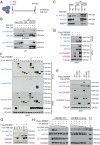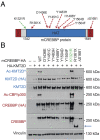KMT2D acetylation by CREBBP reveals a cooperative functional interaction at enhancers in normal and malignant germinal center B cells
- PMID: 36893259
- PMCID: PMC10089214
- DOI: 10.1073/pnas.2218330120
KMT2D acetylation by CREBBP reveals a cooperative functional interaction at enhancers in normal and malignant germinal center B cells
Abstract
Heterozygous inactivating mutations of the KMT2D methyltransferase and the CREBBP acetyltransferase are among the most common genetic alterations in B cell lymphoma and co-occur in 40 to 60% of follicular lymphoma (FL) and 30% of EZB/C3 diffuse large B cell lymphoma (DLBCL) cases, suggesting they may be coselected. Here, we show that combined germinal center (GC)-specific haploinsufficiency of Crebbp and Kmt2d synergizes in vivo to promote the expansion of abnormally polarized GCs, a common preneoplastic event. These enzymes form a biochemical complex on select enhancers/superenhancers that are critical for the delivery of immune signals in the GC light zone and are only corrupted upon dual Crebbp/Kmt2d loss, both in mouse GC B cells and in human DLBCL. Moreover, CREBBP directly acetylates KMT2D in GC-derived B cells, and, consistently, its inactivation by FL/DLBCL-associated mutations abrogates its ability to catalyze KMT2D acetylation. Genetic and pharmacologic loss of CREBBP and the consequent decrease in KMT2D acetylation lead to reduced levels of H3K4me1, supporting a role for this posttranslational modification in modulating KMT2D activity. Our data identify a direct biochemical and functional interaction between CREBBP and KMT2D in the GC, with implications for their role as tumor suppressors in FL/DLBCL and for the development of precision medicine approaches targeting enhancer defects induced by their combined loss.
Keywords: B cell lymphoma; CREBBP; KMT2D; acetylation; germinal center.
Conflict of interest statement
The authors have organizational affiliations to disclose, ASTRA ZENECA: Consulting; NEOGENOMICS: Advisory Board Member, the authors have research support to disclose, ASTRA ZENECA: Research Award CU20-0758.
Figures








Similar articles
-
The CREBBP Acetyltransferase Is a Haploinsufficient Tumor Suppressor in B-cell Lymphoma.Cancer Discov. 2017 Mar;7(3):322-337. doi: 10.1158/2159-8290.CD-16-1417. Epub 2017 Jan 9. Cancer Discov. 2017. PMID: 28069569 Free PMC article.
-
Unique and Shared Epigenetic Programs of the CREBBP and EP300 Acetyltransferases in Germinal Center B Cells Reveal Targetable Dependencies in Lymphoma.Immunity. 2019 Sep 17;51(3):535-547.e9. doi: 10.1016/j.immuni.2019.08.006. Epub 2019 Sep 10. Immunity. 2019. PMID: 31519498 Free PMC article.
-
Inactivation of CREBBP expands the germinal center B cell compartment, down-regulates MHCII expression and promotes DLBCL growth.Proc Natl Acad Sci U S A. 2017 Sep 5;114(36):9701-9706. doi: 10.1073/pnas.1619555114. Epub 2017 Aug 22. Proc Natl Acad Sci U S A. 2017. PMID: 28831000 Free PMC article.
-
Pathogenesis of follicular lymphoma.Best Pract Res Clin Haematol. 2018 Mar;31(1):2-14. doi: 10.1016/j.beha.2017.10.006. Epub 2017 Nov 1. Best Pract Res Clin Haematol. 2018. PMID: 29452662 Review.
-
Human B Lymphomas Reveal Their Secrets Through Genetic Mouse Models.Front Immunol. 2021 Jul 16;12:683597. doi: 10.3389/fimmu.2021.683597. eCollection 2021. Front Immunol. 2021. PMID: 34335584 Free PMC article. Review.
Cited by
-
Mutant EZH2 alters the epigenetic network and increases epigenetic heterogeneity in B cell lymphoma.PLoS Biol. 2025 Jun 12;23(6):e3003191. doi: 10.1371/journal.pbio.3003191. eCollection 2025 Jun. PLoS Biol. 2025. PMID: 40504770 Free PMC article.
-
SETting up the genome: KMT2D and KDM6A genomic function in the Kabuki syndrome craniofacial developmental disorder.Birth Defects Res. 2023 Dec 1;115(20):1885-1898. doi: 10.1002/bdr2.2253. Epub 2023 Oct 6. Birth Defects Res. 2023. PMID: 37800171 Free PMC article. Review.
-
The Role of Chronic Inflammation in Pediatric Cancer.Cancers (Basel). 2025 Jan 6;17(1):154. doi: 10.3390/cancers17010154. Cancers (Basel). 2025. PMID: 39796780 Free PMC article. Review.
-
Loss of CREBBP and KMT2D cooperate to accelerate lymphomagenesis and shape the lymphoma immune microenvironment.Nat Commun. 2024 Apr 3;15(1):2879. doi: 10.1038/s41467-024-47012-1. Nat Commun. 2024. PMID: 38570506 Free PMC article.
-
Modeling the crosstalk between malignant B cells and their microenvironment in B-cell lymphomas: challenges and opportunities.Front Immunol. 2023 Nov 2;14:1288110. doi: 10.3389/fimmu.2023.1288110. eCollection 2023. Front Immunol. 2023. PMID: 38022603 Free PMC article. Review.
References
Publication types
MeSH terms
Substances
Grants and funding
LinkOut - more resources
Full Text Sources
Molecular Biology Databases
Miscellaneous

